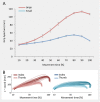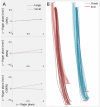Predicting object size from hand kinematics: a temporal perspective
- PMID: 25781473
- PMCID: PMC4364115
- DOI: 10.1371/journal.pone.0120432
Predicting object size from hand kinematics: a temporal perspective
Abstract
Research on reach-to-grasp movements generally concentrates on kinematics values that are expression of maxima, in particular the maximum aperture of the hand and the peak of wrist velocity. These parameters provide a snapshot description of movement kinematics at a specific time point during reach, i.e., the maximum within a set of value, but do not allow to investigate how hand kinematics gradually conform to target properties. The present study was designed to extend the characterization of object size effects to the temporal domain. Thus, we computed the wrist velocity and the grip aperture throughout reach-to-grasp movements aimed at large versus small objects. To provide a deeper understanding of how joint movements varied over time, we also considered the time course of finger motion relative to hand motion. Results revealed that movement parameters evolved in parallel but at different rates in relation to object size. Furthermore, a classification analysis performed using a Support Vector Machine (SVM) approach showed that kinematic features taken as a group predicted the correct target size well before contact with the object. Interestingly, some kinematics features exhibited a higher ability to discriminate the target size than others did. These findings reinforce our knowledge about the relationship between kinematics and object properties and shed new light on the quantity and quality of information available in the kinematics of a reach-to-grasp movement over time. This might have important implications for our understanding of the action-perception coupling mechanism.
Conflict of interest statement
Figures





References
-
- Jeannerod M, Arbib MA, Rizzolatti G, Sakata H. Grasping objects: the cortical mechanisms of visuomotor transformation. Trends Neurosci. 1995;18: 314–320. - PubMed
-
- Jeannerod M. Intersegmental coordination during reaching at natural visual objects. Attention Perform IX. 1981;9: 153–168.
-
- Chieffi S, Gentilucci M. Coordination between the transport and the grasp components during prehension movements. Exp Brain Res. 1993;94: 471–477. - PubMed
-
- Marteniuk RG, Leavitt JL, MacKenzie CL, Athenes S. Functional relationship between grasp and transport components in a prehension task. Hum Movement Sci. 1990;9: 149–176.
-
- Paulignan Y, MacKenzie C, Marteniuk R, Jeannerod M. Selective perturbation of visual input during prehension movements. Exp Brain Res. 1991;83: 502–512. - PubMed
Publication types
MeSH terms
Grants and funding
LinkOut - more resources
Full Text Sources
Other Literature Sources

